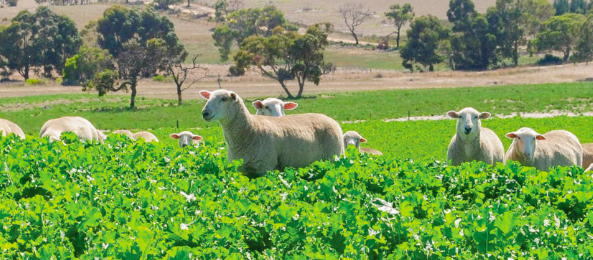Filling the Autumn Feed Gap



What was the Aim?
This project was aimed at beef producers in the Lower South West region, and demonstrated the potential of autumn grazed fodder crops to provide a lower cost and more productive alternative to supplement feeding with conserved fodder in the high rainfall Lower South West region in WA.
The project focused on whether a successful autumn forage crop could allow beef producers in the region to meet weaner target weights and maintain stocking rates during that crucial late summer, early autumn period as well as providing a lower cost feed alternative to fodder conservation.
It was measured through:
- Pasture quality
- Pasture quantity
- Animal performance
- Cost sensitivity analysis

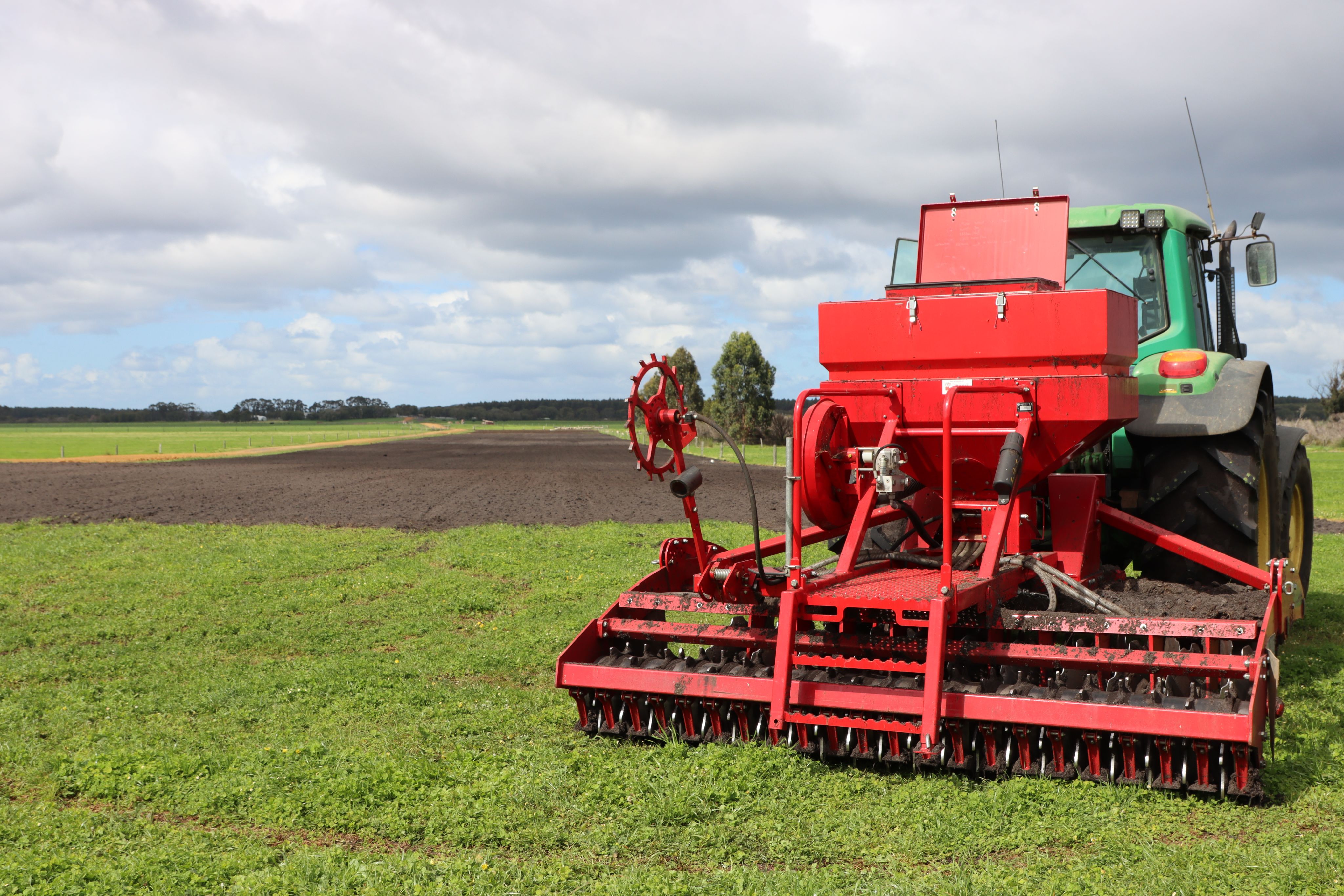

The Structure of the Project
The project took place over 4 years (Jan 2020-Dec 2023)
Year 1:
Year 1 saw two strip demonstration sites established at different locations within the Lower South West region. 15 different autumn fodder varieties (and 2 mixes) in total were seeded across the two sites to see how they performed. At one of the sites (situated in the Scott River area), pasture quality and dry matter were measured and at both sites season length, timing and persistence of each variety was observed. A sensitivity analysis was performed for one site.
Years 2-3:
Years 2 and 3 saw 6 commercial grazing demo sites established across the Region. Each grower selected a mix of varieties to try on an area of paddock. Pasture quality and dry matter were measured at sites where possible and growers collected weight gain data from the animals that were grazed on the demo sites where possible. A sensitivity analysis was performed in year 2 but not in year 3
Year 1

Site 1 - Andrew McNab, Scott River East
Site Characteristics
Landscape:
Low lying flats with a slight rise to drier upslope
Soil Characteristics:
- Sandy
- Very Low PBI but optimum Phosphorus levels
- Potassium levels a little low
- Sulphur levels ok
- Very good Organic Carbon
- No salinity issues
- Low pH
Farming Operation
- Family farm
- Farming since 2000
- 600 Hectares of pasture
- Commercial herd of Angus Cattle and Prime Lamb Flock
- Typical winter pasture of rye grass and sub-clover
Inputs and Costs

Seeding Days
02/10/2020 and 26/10/2020
Demonstration Layout
To prepare for the demo, the site was sprayed out for weeds in early September and cultivated in September & October which resulted in a lovely seedbed. Lime was applied in September and fertiliser applied just prior to seeding. Each strip was approximately 3m wide and 360m long.



Demonstration Site Layout

Varieties Seeded
10 different varieties were seeded on 02/10/2020. The remaining 3 varieties (SSS, Sorghum and LabLab) had higher soil temperature requirements. Therefore they were seeded later on the 26/10/20 when the soil temperature measured 18C. 3 pasture quality and dry matter cuts were taken at this site over the growing season.
Seeder Logistics
A Speed Tiller was used. The seeding rates for each variety were calculated, the seed required weighed out and then due to the different size of each seed, the seeder roller settings needed to be adjusted and calibrated on each run to account for the differing sizes. After each run the remaining seed was removed and weighed to calculate actual seeding rate. The seeder was then cleaned out to avoid cross contamination of species

Site 2 - Asher Cohen, Forest Grove
Site Characteristics
Landscape:
Range of good loam soil types some wet areas
Soil Characteristics:
- Loamy Clay
- Very High PBI but very low Phosphorus levels
- Potassium levels okay
- Sulphur levels okay
- Good Organic Carbon
- No salinity issues
- Borderline pH (on the low side)
Farming Operation
- Farming since 2017
- Approximately 65 hectares
- Currently 30 cattle but increasing the herd
- Typical pastures of clover, rye, some chicory and kikuyu
Inputs and Costs

Seeding Days
05/10/2020
Demonstration Layout
To prepare for the demo, the site was cultivated twice in Sept. This site wasn’t sprayed for weeds as Asher preferred to just use mechanical cultivation for weed control. Lime was applied in September and fertiliser applied just prior to seeding. Each strip was approximately 2.3m wide and 200m long.



Demonstration Site Layout

Varieties Seeded
12 different varieties plus 2 mixes (Summer mix and a perennial mix) were seeded on 05/10/2020. Pasture quality and dry matter cuts were not taken at this site. It was an observation site only.
Seeder Logistics
A Duncan Duel Box Eco Seeder was used. The seeding rates for each variety were calculated, the seed required weighed out and then due to the different size of each seed, the seeder settings needed to be adjusted and calibrated on each run to account for the differing sizes. After each run the remaining seed was removed and weighed to calculate actual seeding rate. The seeder was then cleaned out to avoid cross contamination of species.
Varieties
Cocksfoot
Suggested Seeding Rate: 5kg/ha
Actual Seeding Rate: Scott River - 5kg/ha, Forest Grove - 10kg/ha
Cost per ha: $100 at 5kg/ha and $100-$200 as seeded
- Poor establishment, not competitive
- Did not survive heavy grazing Needs careful management and higher seed rates?
Chicory
Variety: Puna II, PGG Wrightson
Suggested Seeding Rate: 5kg/ha
Actual Seeding Rate: Scott River - 6.26kg/ha, Forest Grove - 6kg/ha
Cost per ha: $130 at 5kg/ha and $160 as seeded
- Good establishment, yield and feed quality
- Survived heavy grazing and still growing
- Limited broad leaf weed control options
Plantain
Variety: Ecotain, PGG Wrightson
Suggested Seeding Rate: 4kg/ha
Actual Seeding Rate: Scott River - 5.5kg/ha, Forest Grove - 6kg/ha
Cost per ha: $90 at 4kg/ha and $124 as seeded
- Good establishment and early yield/quality, preferred by sheep
- Did not survive heavy grazing (more potential)
- Limited weed control options
Raphno
Variety: Pallaton, PGG Wrightson
Suggested Seeding Rate: 8kg/ha
Actual Seeding Rate: Scott River - 7.72/ha, Forest Grove - 13.5kg/ha
Cost per ha: $285kg/ha and up to $430 as seeded
- Good establishment and grazing survival
- Diamond back moth need management with insecticides or sowing time
Forage Brassica
Suggested Seeding Rate: 6kg/ha
Actual Seeding Rate: Scott River - 4.6kg/ha, Forest Grove - 4.34kg/ha
Cost per ha: $60 at 6kg/ha and $46 as seeded
- Good establishment and grazing survival
- Diamond back moth need management with insecticides or sowing time
Turnip
Suggested Seeding Rate: 4kg/ha
Actual Seeding Rate: Scott River - 3kg/ha, Forest Grove - 16kg/ha
Cost per ha: $60 at 4kg/ha and $45 as seeded up to $240
- Good establishment
- Less tolerant of heavy grazing
- Diamond back moth need management with insecticides or sowing time
Millet - Soil temp of 14C +
Variety: Shiroie, PGG Wrightson
Suggested Seeding Rate: 15kg/ha
Actual Seeding Rate: Scott River - 10kg/ha, Forest Grove - 17.8kg/ha
Cost per ha: $70 at 15kg/ha and $47 as seeded at Scott River
- Good establishment and dry matter production
- Can be sown at lower soil temp (earlier into better moisture)
- Lower feed quality Low risk option
SSS - Soil temp of 17C and rising
Variety: Super Sweet Sudan, Pioneer Seeds
Suggested Seeding Rate: 5kg/ha
Actual Seeding Rate: Scott River - 5.2kg/ha (seeded 26/10/20)
Cost per ha: $70 at 5kg/ha
- Did not get favourable conditions at this site (more potential though)
Sorghum
Suggested Seeding Rate: 5-10kg/ha
Actual Seeding Rate: Scott River - 8kg/ha (seeded 26/10/20), Forest Grove - 10kg/ha
Cost per ha: $90 as seeded
- Did not get favourable conditions at this site (more potential though)

LabLab
Variety: Highworth, PGG Wrightson
Suggested Seeding Rate: 15kg/ha
Actual Seeding Rate: Scott River - 15.7kg/ha (seeded 26/10/20)
Cost per ha: $70 at 15kg/ha
- Did not appear to be suited to our environment. Perhaps Soil temperature was not sufficient.
Lucerne
Variety: Stamina GT6, PGG Wrightson
Suggested Seeding Rate: 12kg/ha
Actual Seeding Rate: Forest Grove - 10.9kg/ha
Cost per ha: $120/ha
- Poor establishment, possibly insect attack (Red Legged Earth Mite)

Summer Mix
Suggested Seeding Rate: 25-30kg/ha
Actual Seeding Rate: Forest Grove - 30kg/ha
Cost per ha: $165/ha
- Was not cut but looked good.
Pasture Cut Results - Scott River Site
The following images show the Dry Matter and Pasture Quality Data from 3 pasture cuts that were taken at the Scott River Site. Not all varieties that were grown at the demo site appear in the testing table, this is because at the time of the pasture cut there was insufficient growth to warrant a cut.
Despite the excellent seed bed preparation, Blackberry Nightshade germinated across the site. With so many species present herbicide control options were not possible. Heavy grazing was utilised as an alternative and some species were grazed harder than others. The effect of this heavy grazing was that some species did not survive the dry spell following grazing.
The species that did not survive the first graze could potentially produce a lot more dry matter when managed as an individual stand where grazing can be better controlled.
To briefly summarise the feed quality results:
• Generally broad leaf crops had higher energy, protein and digestibility than summer grasses. However, the broad leaf varieties alone may not provide a balanced diet for the animals and they most likely would need additional fibre to get that balance (perhaps including a summer grass or another fibre supplement).
• The Perennial Rye was on par with the broad leaf crops but there is data from one cut only
Note: No pasture cuts were taken from the Forest Grove Site as it was an observation only site.
Cumulative Pasture Cut Results
The below graph shows the cumulative dry matter yields of species over the three cutting times. Only chicory produced dry matter at each cut. Other species either had not survived, gone reproductive (millet) or had insufficient density to obtain a representative cut.
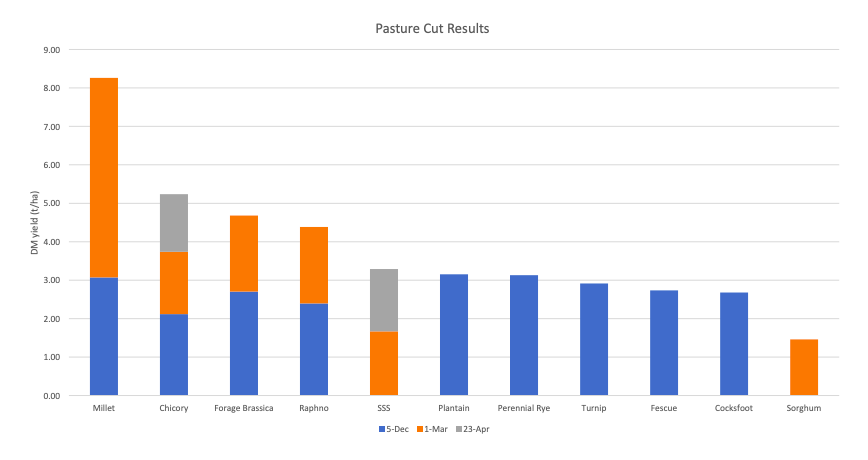



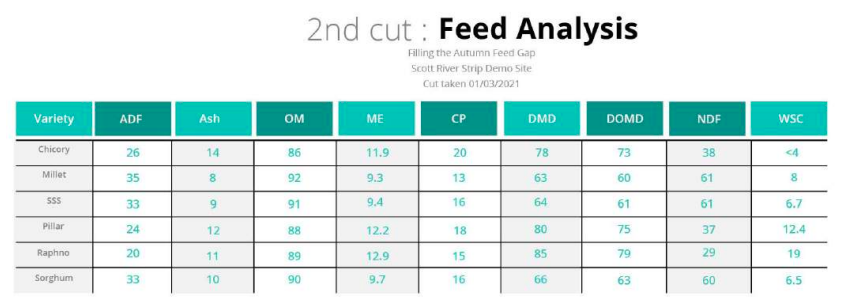
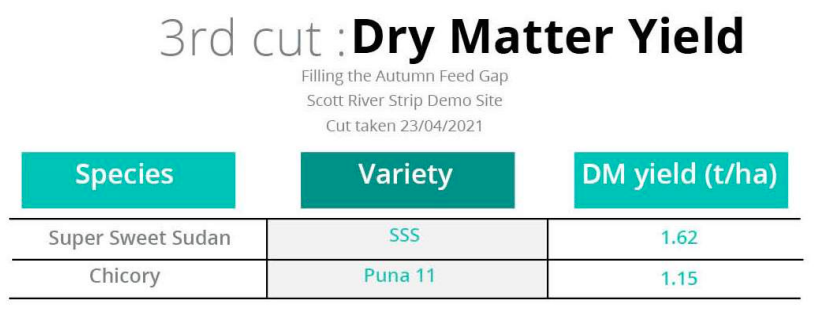

Soil Temperature and Rain

Table 1
Table 1
Table 1 graph shows the Rainfall and soil temperatures for the growing period at the Scott River site. Note the dry period between December 2020 and February 2021.
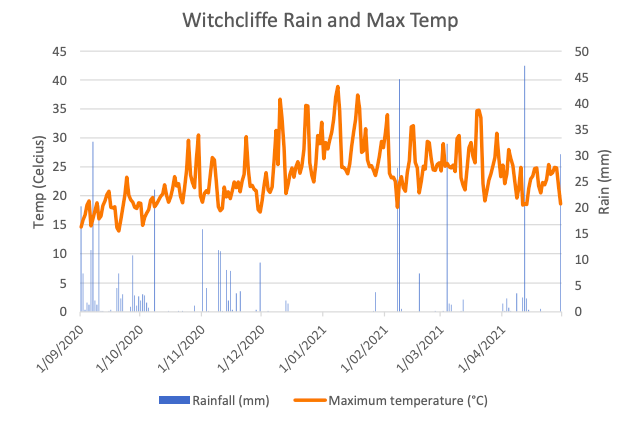
Table 3
Table 3
Cost/Benefit: Cost per Tonne of Dry Matter
Table 4 shows a sensitivity analysis for the cost per tonne of dry matter at various input costs and dry matter yields. Hay at $50/bale represents a dry matter cost of $150/t. Summer fodder species that can produce dry matter for less than $150/t can be considered a cost effective enterprise.

Table 2
Table 2
Table 2 shows the Rainfall and soil temperatures for the seeding period. The dates that seeding occurred for the Scott River Site were 02/10/2020 and 26/10/2020 and the seeding date for the Forest Grove Site was 05/10/2020. Soil temperature data suggests that seeding of temperature dependent species could have been delayed until early December, however moisture availability for germination may have been limiting at this time.
Table 3 shows the Rainfall and soil temperatures for the growing period at the Forest Grove site. Note the dry period between December 2020 and March 2021.

Table 4
Table 4
Summary of Year 1
Soil Temperature
Soil temperature is a key factor in successful establishment establishment of certain species. Where others can be sown earlier into moisture with no or lower soil temperature requirements.
Species that have soil temperature requirement for good establishment may need late rains to ensure establishment and growth.
Those species that can be sown into cooler soils can be planted on spring soil moisture, reducing risk of inadequate moisture for establishment.
There is also the need to consider the potential loss of existing spring production when chasing good establishment of some these. In the Scott River demonstration, 3t/ha of dry matter was produced in the first cut in early December, making up for some of the lost production from paddock preparation autumn fodder varieties.
Pest Control
Diamond Back Moth management for forage brassicas is critical. Need to consider options such as chemical and biological controls but also planting time.
Grazing
Need to consider the grazing tolerance of each variety. Some of the varieties seeded had better grazing tolerance than others Varieties that did not handle heavy grazing still have potential but just need careful grazing management.
Year 2



Site 1 - Ben Sieber
4ha, Margaret River


Site 2 - Jeff John
8ha, Karridale
The following seed was prepared for Jeff John’s site:
- 6.25kg/ha Millet
- + 1.9kg/ha SSS
- + 2kg/ ha red clover
- +2kg/ha chickory
- + 2kg/ha buster radish
However, it was too dry to seed at the time and so this site will be postponed until the 2022/23 season

Preparing the seed at Jeff John’s site
Preparing the seed at Jeff John’s site





Site 3 - Simon Creagh
5ha, Nillup
The planned paddock was too dry to sow so the demo site was moved to a wet area of a different paddock.

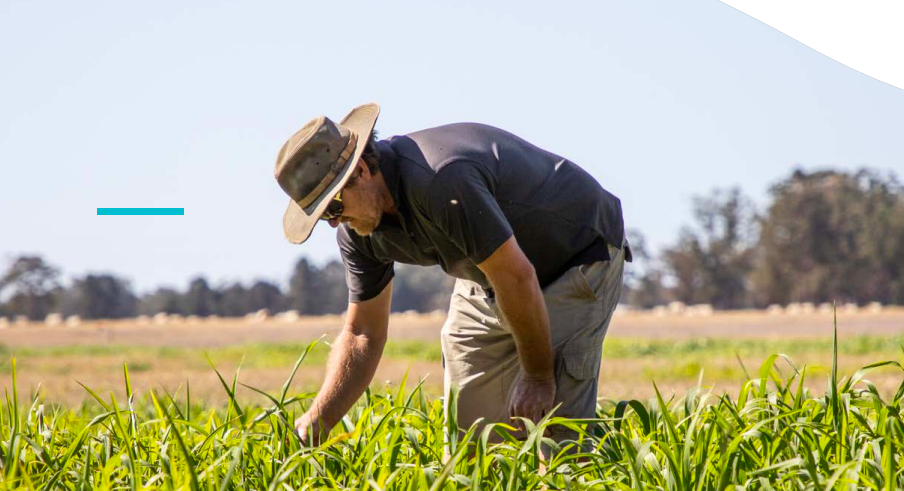
Checking the demo site at Simon Creagh’s - January 19th 2022
Checking the demo site at Simon Creagh’s - January 19th 2022
Site 4 - Andrew McNab
10ha Scott River East
Andrew’s demo was an interesting comparison site as he hosted one of the first year demo sites as well. It was very clear the impacts that very different seasons can have. These two photos show Andrew’s demonstration site on the 19th of Jan 2022 (side photo) and Andrew’s demonstration site the previous year on the 1st of March 2021 (bottom photo)


Demonstration site the previous year on the 1st of March 2021
Demonstration site the previous year on the 1st of March 2021

Demonstration site on the 19th of Jan 2022
Demonstration site on the 19th of Jan 2022

Demonstration site on the 19th of Jan 2022
Demonstration site on the 19th of Jan 2022


Site 5 - Daryl Avery
55ha, Scott River East
The individual frames of a traditionally animated film are photographs of drawings that are first drawn on paper.


Daryl’s demo site - 19th Jan 2022
Daryl’s demo site - 19th Jan 2022
Soil Temperature and Rain
The summer of 2021/22 was a very different season to that of the previous year’s demonstration. As shown in the results in this case study, this had quite the impact on this year’s demonstration sites.
Table 1.1 shows the 2020 summer rain and average soil temp for the area
Table 1.2 shows the 2021 summer rain and average soil temp for the area.
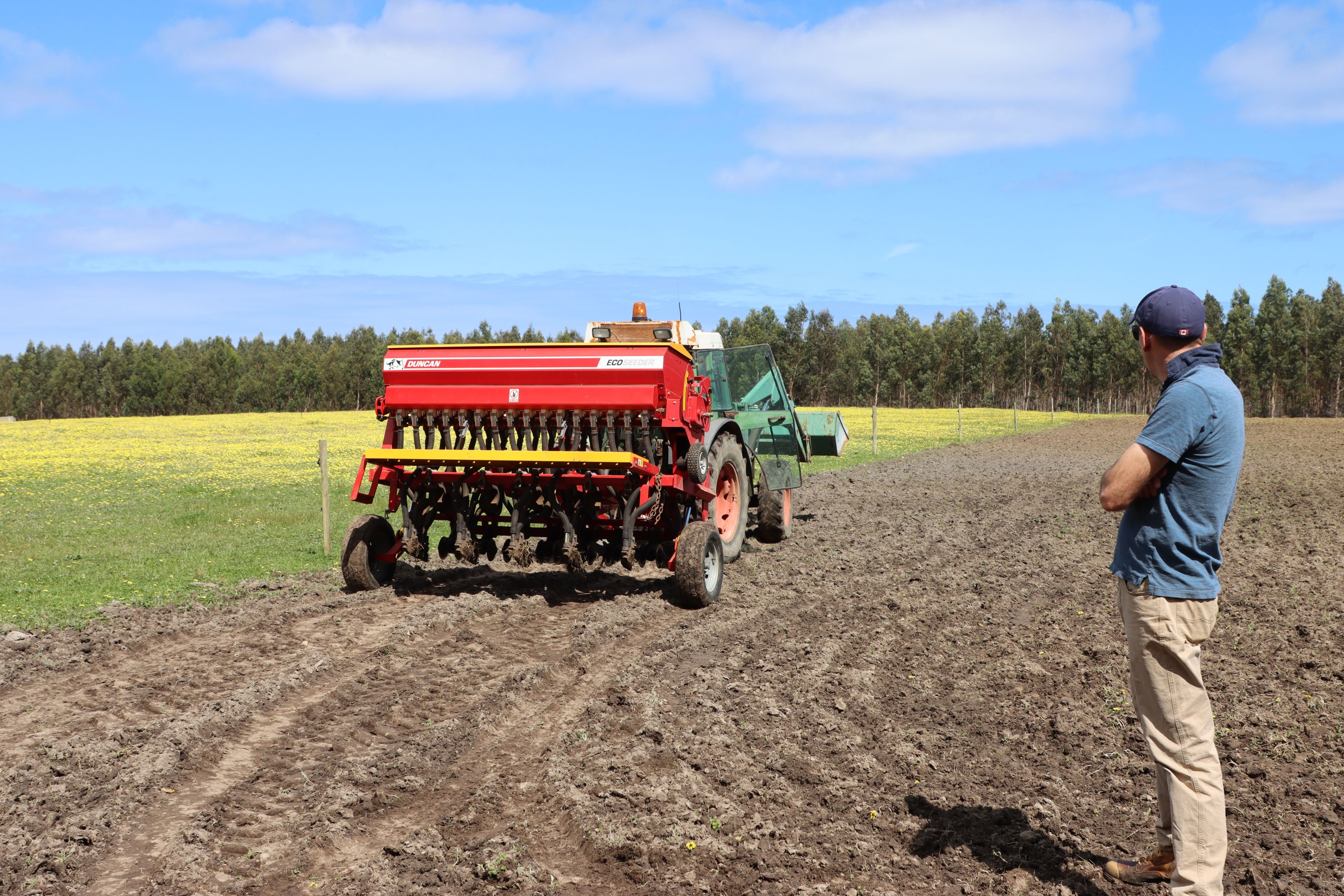
Cost of Production & Profitability



Table 1.1
Table 1.1
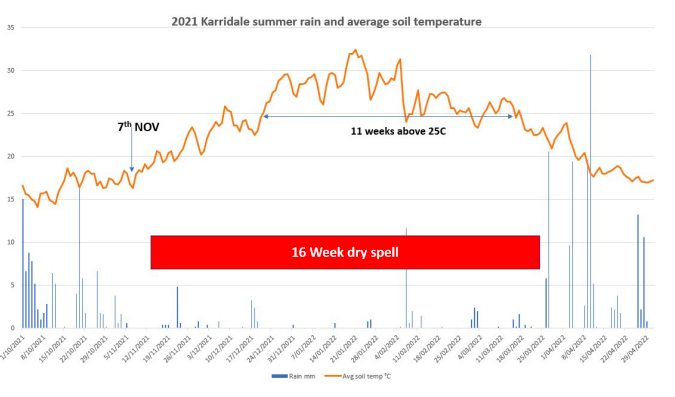
Table 1.2
Table 1.2
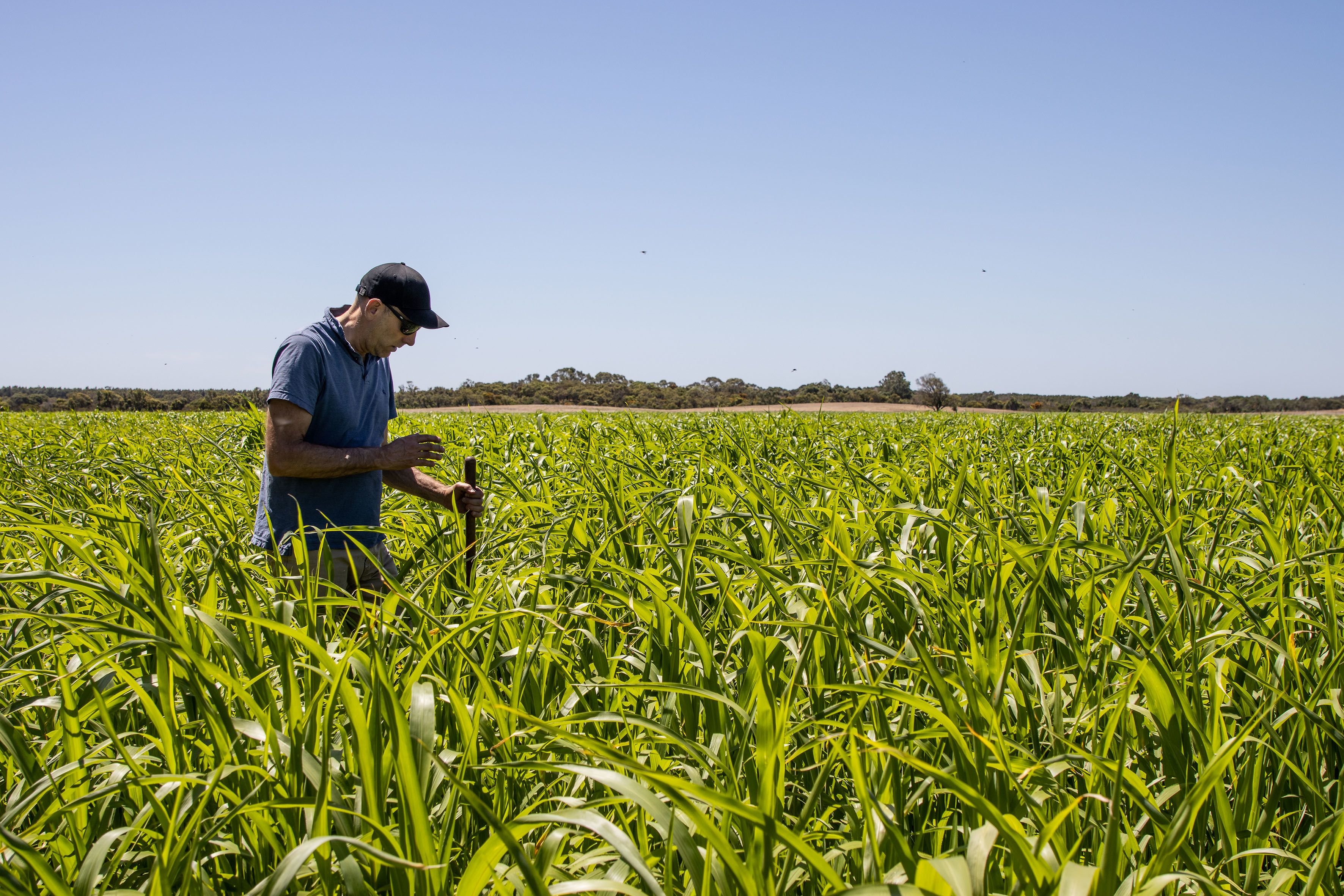
Cost/Benefit: Cost per Tonne of Dry Matter

*Above figures based on Silage costs of approx. $100/t DM to conserve
Summary of Year 2
- In a very dry warm summer profitability was variable.
- Summer fodder species can be opportunistic or grown for the benefit of the following winter pasture production.
- Timing important to get the crop up and able access spring moisture as profile dries. Follow-up rains are needed to get big crops.
- Silage can grow animals at similar growth rates
- Work on seeding rates to reduce risk
Year 3

Site 1 - Daryl Avery
55ha, Scott River East

There was a record of lower protein in Daryl's 1st site, this was because it was more advanced, thus it is to be expected.




Site 2 - Sam Weightman
Forest Grove

Metabolizable energy was good and protein was low as expected given that no Nitrogen fertiliser was applied.
There was evidence of lower NDF and higher digestibility due to the crop being less advanced.
Learnings

This project was an important step forward in highlighting feedbase issues in the dry seasons in the Lower South West region that interested and engaged a substantial number of producers.
The aim of the project was to demonstrate the potential of autumn grazed fodder crops that will provide a lower cost and more productive (measured by pasture quality, quantity, animal performance and cost benefit analysis) alternative to supplement feeding with conserved fodder for beef in the high rainfall Lower South West region in WA.
Firstly, it was found that unless there was a substantial summer rain event/s then it was difficult to maintain pasture production through to the autumn period as most of the pasture growth and grazing actually occurred during summer. The pasture growth at the demonstration sites relied heavily on soil moisture and soil temperature and this was demonstrated through the pasture growth variation that was seen between demo sites with different soil characteristics and rainfall in the same year and also on the same sites in differing years.
Through the animal weights that were collected, it was also seen that supplement feeding with silage through the warmer months produced comparable animal weight gains at one site (growth rates >1kg/hd/day when feeding out silage).
It was concluded that due to the reliance on seasonal conditions, summer/autumn crops can be best utilised as one feedbase tool that can be very beneficial if the conditions are right. However, it is high risk (and depending on the variety, high cost) to rely on summer/autumn crops as the main feedbase if not irrigating.
Cheaper species with lower soil temperature requirement (e.g. millet) can be grown on spring soil moisture and be used to replace poor quality low yielding weeds with a good quality feed at the same time preparing the paddock for a winter renovation
Key Findings
Key findings from the 3 seasons of seeding included:
- The importance of summer rain needed to sustain the crop through to autumn. We saw huge differences at our Scott River site between year 1 and year 2 where year 1 received a big summer rain event and achieved huge pasture yields and year 2 saw crop failure in a very hot and dry summer. Because of this reliance on seasonal conditions, summer/autumn crops can be best utilised as one feedbase tool that can be very beneficial if the conditions are right. However, it is high risk to rely on summer/autumn crops as the main feedbase if not irrigating. Analysis of rainfall data from Karridale showed that in the last ten years one in two years produced summer rainfall events to generate large dry matter yields in summer crops.
- The potential to use summer crops as a tool to prepare paddocks for winter renovation was also highlighted. The paddocks were already clean and prepped and made for a great start for autumn seeding.
- Soil temperature is a key factor in successful establishment establishment of certain species. Where others can be sown earlier into moisture with no or lower soil temperature requirements. Species that have soil temperature requirement for good establishment may need late rains to ensure establishment and growth. Those species that can be sown into cooler soils can be planted on spring soil moisture, reducing risk of inadequate moisture for establishment. There is also the need to consider the potential loss of existing spring production when chasing good establishment of some these. In the Scott River demonstration, 3t/ha of dry matter was produced in the first cut in early December, making up for some of the lost production from paddock preparation. autumn fodder varieties
- Diamond Back Moth management for forage brassicas is critical. Need to consider options such as chemical and biological controls but also planting time.
- Need to consider the grazing tolerance of each variety. Some of the varieties seeded had better grazing tolerance than others Varieties that did not handle heavy grazing still have potential but just need careful grazing management.
- Good quality silage can grow animals at similar rates over the dry season and for comparable costs.




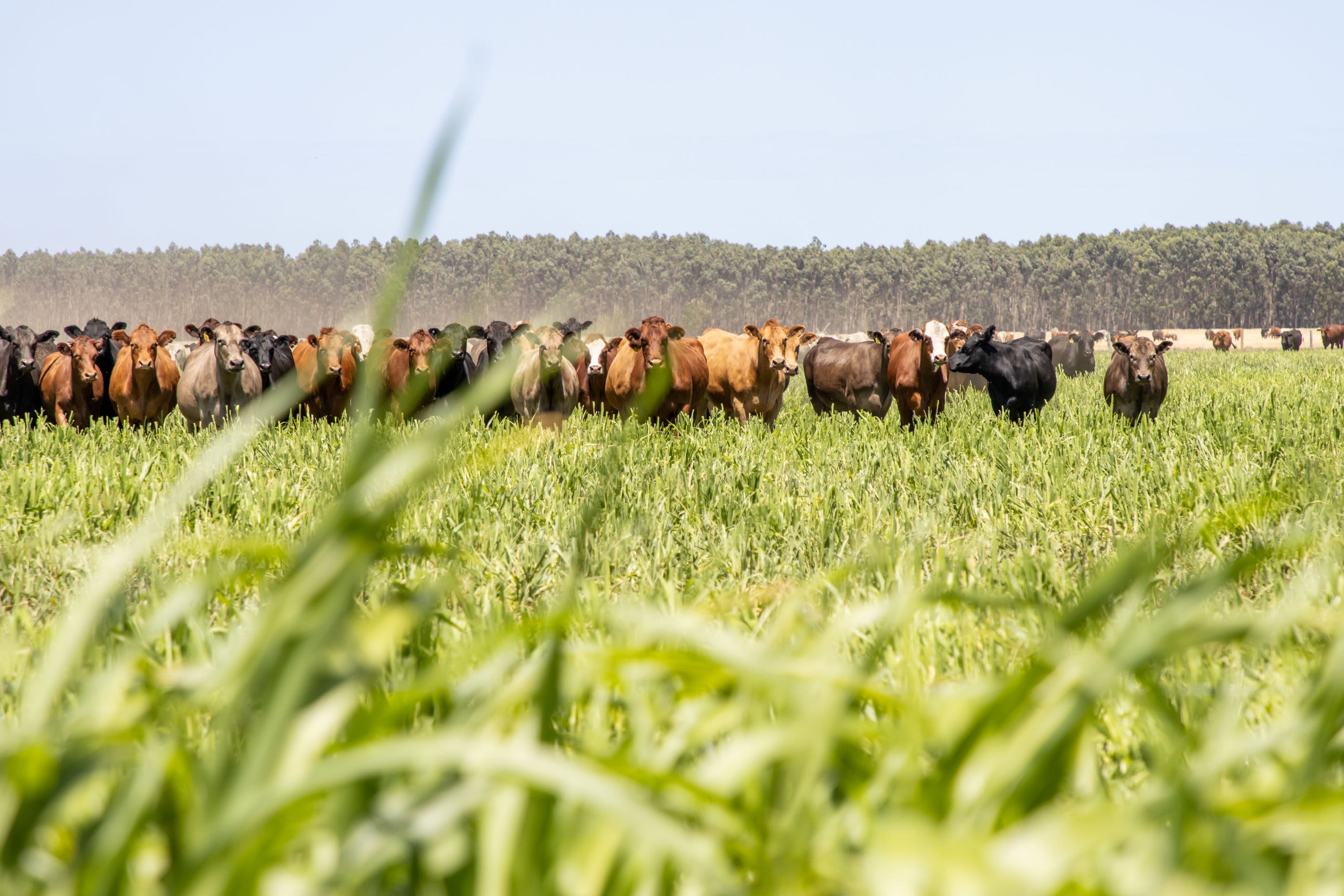
This Producer Guide was completed by The Lower Blackwood Land Conservation District Committee as a Part of MLA's Autumn FeedGap Project







